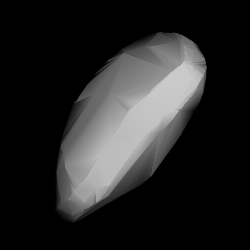 Modelled shape of Bok from its lightcurve | |
| Discovery[1] | |
|---|---|
| Discovered by | E. Roemer |
| Discovery site | Catalina Stn. |
| Discovery date | 9 June 1975 |
| Designations | |
| (1983) Bok | |
Named after | Bart Bok and Priscilla Fairfield Bok[2] |
| 1975 LB · 1950 RV 1963 UJ | |
| main-belt · (middle)[3] | |
| Orbital characteristics[1] | |
| Epoch 4 September 2017 (JD 2458000.5) | |
| Uncertainty parameter 0 | |
| Observation arc | 66.73 yr (24,372 days) |
| Aphelion | 2.8796 AU |
| Perihelion | 2.3632 AU |
| 2.6214 AU | |
| Eccentricity | 0.0985 |
| 4.24 yr (1,550 days) | |
| 260.33° | |
| 0° 13m 55.92s / day | |
| Inclination | 9.4133° |
| 23.557° | |
| 346.78° | |
| Physical characteristics | |
| 10.08 km (calculated)[3] 15±3 km[4] 15.70±0.24 km[5] | |
| 10.70±0.01 h[4] | |
| 0.034±0.015[5] 0.06±0.02[4] 0.10 (assumed)[3] | |
| C[4] · S/C[3] | |
| 12.83±0.10[4] · 13.1[1][3] · 13.10±0.22[6] · 13.32[5] | |
1983 Bok (prov. designation: 1975 LB) is a dark background asteroid from the central region of the asteroid belt. It was discovered on 9 June 1975, by American astronomer Elizabeth Roemer at the Catalina Station of the UA's Steward Observatory in Tucson, Arizona, and named for Bart Bok and Priscilla Fairfield Bok.[2][7] The carbonaceous C-type asteroid has a rotation period of 10.7 hours and measures approximately 15 kilometers (9.3 miles) in diameter.
- ^ a b c Cite error: The named reference
jpldatawas invoked but never defined (see the help page). - ^ a b Cite error: The named reference
springerwas invoked but never defined (see the help page). - ^ a b c d e Cite error: The named reference
lcdbwas invoked but never defined (see the help page). - ^ a b c d e Cite error: The named reference
Casalnuovo-2015was invoked but never defined (see the help page). - ^ a b c Cite error: The named reference
Masiero-2012was invoked but never defined (see the help page). - ^ Cite error: The named reference
Veres-2015was invoked but never defined (see the help page). - ^ Cite error: The named reference
MPC-Bokwas invoked but never defined (see the help page).